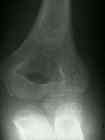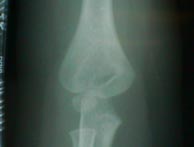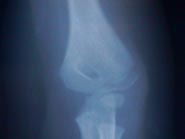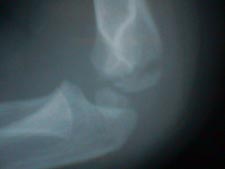
- Adult Lateral Condylar Fractures
- Pediatric Elbow
- Discussion:
- common frx in children (20% of pediatric elbow frx);
- occurs most often between 6-10 yrs of age;
- mechanism: fall on the outstretched arm w/ forearm in abduction & elbow in extension;
- fractures of the lateral condyle of humerus are unstable & tend to become displaced even when immobilized because
of pull of forearm extensors;
- these frxs are also prone to non union since the frx is intra-articular & is bathed in synovial fluid;
- patients will generally have only lateral sided elbow pain (and absence of medial sided pain, unless a medial type II varient
is present);
- associated injuries: elbow dislocation;
- anatomy of lateral condyle:
- ossification center of lateral condyle appears between 18 mo & two yrs
- it extends medially to form main part of lower articular end of humerus;
- lateral epicondyle ossifies at age 13 & fuses w/ capitellum at age 16;
- radial collateral ligament, supinator, & forearm extensors are attached;
- anatomy of fracture:
- milch type I frx:
- salter-harris IV fracture in which the frx traverses the ossification center of the capitellum so that the lateral wall of the
trochlea remains attached to the main portion of the humerus;
- because frx line lies lateral to capitello-trochlear groove, elbow is stable and relationship between the forearm and
humerus remains intact;
- less common variant than type II fractures;
- milch type II frx:
- most common variant;
- involves a frx line beginning at lateral side of distal metaphysis of humerus & extends obliquely downward & medial
to capitellum (or in some cases through the trochlear groove), traverses physis, and enters the joint in lateral
portion of trochlea;
- frx described as being a SH type II physeal fracture;
- distal fragment contains epiphysis of capitellum, lateral trochlea & epicondyle, as well as part of metaphysis w/ radial
collateral ligaments and forearm extensor tendons;
- this frx passes across the trochlear groove which can therefore allows subluxation of the ulna (lateral wall of the trochlea
remains attached to fractured condylar fragment);
- w/ non displaced fractures, determine whether there is lateral elbow tenderness, and whether lateral elbow tenderness
increases with elbow flexion;
- medial type II varient:
- some type II frxs will not exit through the trochlea but will instead exit at the medial aspect of the physis;
- this is a Salter Harris type II fracture;
- it may be difficult to distinguish between a classic lateral type II frx and a medial type II varient when trochlea and medial
epicondyle remain unossified;
- on exam, look for medial tenderness and swelling;

- Radiographic Anatomy of Pediatric Elbow:
- diagnosis may be difficult before the capitellum is ossified (around age 9-10);
- Lateral elbow ecchymosis as a clinical sign of lateral humeral condylar fractures.
- frx line may not be apparent until 7-10 days following injury;
- less severe displacement may also have a translational component;
- look for lateral soft tissue swelling on AP radiographs;
- significant step-off of the lateral cortex, which may indicate that there is significant articular discontinuity;
- remember the frx anatomy extends in a posterolateral direction so that often on the AP view there is only a
faintly discernable frx line just above capitellum, but on lateral (or oblique view), frx line is more visible,
extending posteriorly, laterally, and superiorly;
- oblique radiograph
- with the arm internally rotated will best demonstrate amount of displacement & rotation of lateral condyle fragment;
- often multiple oblique radiographs will be needed to accurately determine whether frx is displaced or non displaced;

- references:
- Internal oblique radiographs for diagnosis of nondisplaced or minimally displaced lateral condylar fractures of the humerus in children.
- Twenty-degree-tilt radiography for evaluation of lateral humeral condylar fracture in children.
- arthrogram:
- may be indicated when the diagnosis is strongly suspected but cannot be confirmed;
- stress views:
- varus stress views (with appropriate anesthesia) may be required to help asses frx stability;
- normal varients:
- note that on lateral radiographs, the normal physis may be wider posteriorly than anteriorly;
- the lateral epicondyle epiphysis will show up as a distinct ossification center;
- MRI:
- may be indicated for apparently non-displaced lateral condyle frx which are felt to be suitable for non operative treatment;
- younger children will probably not have the disipline to sit still during the MRI;
- Non Operative Treatment:
- indications for non operative treatment:
- can only be considered for truly non-displaced fractures w/ intact joint surface;
- truly non displaced fractures will most often have minimal lateral soft tissue swelling, and the presence of significant soft tissue
swelling may indicate an unstable fracture;
- consider obtaining a radiographic series in full elbow extension since this will accentuate frx displacement, which also
allows an assessment of stability;
- arthrography:
- probably indicated from most "non-displaced" lateral condyle frx;
- if the frx is non displaced but the fracture extends into the joint surface then percutaneous pinning is probably indicated;
- in some cases the frx may be found to be a transepiphyseal frx, which may not require treatment;
- reference: Usefulness and accuracy of arthrography in management of lateral humeral condyle fractures in children.
- cast treatment:
- a truly non-displaced frx can be treated w/ immobilization in a long arm cast w/ elbow in 90 deg of flexion & forearrm in
pronation to minimize the pull of the extensor muscles;
- even undisplaced fractures of the lateral condyle are unstable and may become displaced while immobilized in the cast
- due to risk of late displacement, pt must have frequent f/u every 2 weeks;
- cast is removed at each visit and both AP & oblique x-rays are taken;
- if fracture has displaced, proceed with surgical reduction;
- immobilization is required for about 6 weeks;
- references:
- Nondisplaced and minimally displaced fractures of the lateral humeral condyle in children: a prospective radiographic investigation of fracture stability.
- Prevention and treatment of non-union of slightly displaced frx of lateral humeral condyle in children. An end-result study.
- case example:
- 3-year-old male who presented with a minimally displaced lateral condyle fracture, w/ comparison views on the right side;
- the patient was casted and presented back to clinic several days later w/ significant displacement;
- Operative Treatment:
- closed reduction percutaneous pinning:
- fixation consists of two laterally placed pins;
- following closed reduction and lateral pin insertion, an anatomic reduction can be confirmed w/ an intra-operative arthrogram;
- references:
- Percutaneous Pinning in the Treatment of Displaced Lateral Condyle Fractures.
- Closed reduction and internal fixation of displaced unstable lateral condylar fractures of the humerus in children.
- indications for open reduction:
- displaced lateral condylar frx (> 2 mm) usually cannot be reduced w/ closed means, & preferred treatment is ORIF w/ one or
two smooth pins;
- type IV frx, accurate anatomic repositioning is imperative to decrease the likelihood of growth plate damage;
- congruity of the joint must be restored;
- technique of open reduction internal fixation:
- indicated for any minimally displaced fracture;
- may be performed thru a Kocher incision placed over lateral aspect of elbow;
- more proximally dissect thur the brachioradialis - triceps interval;
- posterior aspect of frx fragment is left undisturbed because it is the source of the blood supply to the capitellum;
- in children, vascular supply of trochlea is vulnerable to injury,
- this approach yields poor visualization and only the lateral cortex is visualized (which makes reduction difficult);
- may also be performed thru a modified posterior approach;
- this approach gives the better exposure than the lateral approach;
- Gruber, et al (1996), 12 patients w/ displaced lateral condylar frx underwent fixation w/ a posterior approach;
- none developed AVN of the capitellum;
- initially stabilize the frx fragment w/ a towel clip;
- stabilize reduction w/ two K-wires placed through puncture wounds in skin posterior and lateral to initial skin incision;
- repair of the torn periosteum and extensor-supinator fascial origin inorder to add to the frx stability;
- postoperatively, the arm is immobilized in a cast for 4-6 weeks;
- Thomas DP, et al, the authors assessed whether a period of 3 weeks, rather than commonly used 6 weeks, of smooth K wire
fixation and casting of elbow was sufficient to achieve union of displaced frx of lateral humeral condyle treated by open reduction;
- the authors found only one nonunion in a case series of 104 children treated with 3 weeks of fixation;
- infections occurred in two children (2%);
- late review of 63 children (61%) showed abnormalities of elbow shape in 28 (44%) and wide surgical scars in 43 (68%);
- abnormalities of elbow shape were mainly due to overgrowth of the lateral humeral condyle, to the formation of excessive
amounts of bone over the outer surface of the condyle, or both;
- references:
- The posterior approach to the elbow revisited.
- Three weeks of Kirschner wire fixation for displaced lateral condylar fractures of the humerus in children.
- [Functional results of displaced lateral condyle fractures of the humerus with four-week K-wire fixation in children].
- Biomechanical Analysis of Lateral Humeral Condyle Fracture Pinning
- Complications: of delayed or inadequate reduction;
- non union:
- will result in progressive cubitus valgus due to retardation of growth of lateral condyle & continued growth of medial condyle;
- w/ osteosynthesis, always use bone grafts to facilitate union;
- references:
- Prevention and treatment of non-union of slightly displaced fractures of the lateral humeral condyle in children. An end-result study.
- Osteosynthesis for old, established non-union of the lateral condyle of the humerus.
- Nonunion of slightly displaced fractures of the lateral humeral condyle in children: an update.
- Ununited fracture of the lateral condyle of the humerus. A 50 year follow-up.
- Late open reduction internal fixation of lateral condyle fractures.
- Percutaneous screw fixation promotes healing of lateral condyle nonunion in children.
- Osteosynthesis In Situ for Lateral Condyle Nonunion in Children
- A new surgical technique for old ununited lateral condyle fractures of the humerus in children.
- lateral spur:
- Lateral Spurring (Overgrowth) After Pediatric Lateral Condyle Fractures
- ulnar nerve palsy:
- over several years, ulnar nerve is repeatedly stretched by motion of elbow over apex of deformity, & becomes inflamed
behind medial condyle;
- typically symptoms are not seen until second decade;
- at earliest signs of neuritis, ulnar nerve should undergo transposition;
- AVN of capitellum:
- will cause growth distrubance & deformity of capitellum & radial head;
- during exposure, posterior aspect of frx fragment is left undisturbed because it is source of blood supply to the capitellum;
- in children, vascular supply of trochlea is vulnerable to injury;
- in the study by Wattenbarger JM, et al, the records of 11 children with an open capitellar physis and a malunion or a nonunion
treated >3 weeks after injury were reviewed;
- there were no cases of AVN and 3 patients had occasional pain;
- 4 patients had displacement of >10 mm before surgery;
- in fractures with >1 cm of displacement, fragment position was minimally improved surgically, but final alignment and
range of motion were good;
- risk of AVN with late open reduction of LCF at >3 weeks is reduced if no tissue is stripped off frx fragment posteriorly;
- ref: Late open reduction internal fixation of lateral condyle fractures.
- growth arrest:
- ref: Growth Arrest of the Capitellar Physis After Displaced Lateral Condyle Fractures in Children
- cubitus varus:
- a more common complication than cubitus valgus;
- may be due to over-stimulation of the lateral condylar condylar physis;
- cubitus valgus:
- malunion & premature growth arrest of lateral condyle will cause progressive cubitus valgus;
- this may occur with or without union of the condylar fragment;
- deformity of elbow is corrected by opening wedge osteotomy of distal humerus w/ graft wedge & ulnar nerve
is transposed anteriorly;
- osteotomy may be indicated for cubitus valgus more than 20 deg;
- this procedure has better results in children than adults, and in adults this procedure is mainly indicated for severe pain or
loss of function;
- reduction of fragment is difficult in late cases and should be attempted only when the fragment is severely displaced;
- tardy ulnar nerve palsy appears as a late complication;
- references:
- Supracondylar dome osteotomy for cubitus valgus deformity associated with a lateral condylar nonunion in children.
- Deformity after fracture of the lateral humeral condyle in children.
- Delayed management of fracture of the lateral humeral condyle in children.
- Late surgical treatment of lateral condylar fractures in children.
Open reduction and internal fixation for the treatment of fractures of the lateral humeral condyle with an early delayed presentation in children: a radiological and clinical prospective study.
Lateral condyle fractures: missed diagnoses in pediatric elbow injuries.
Injuries of the lateral humeral condyle in children.
Lateral humeral condylar fractures in children: a report of 47 cases.
The posterior approach to the elbow revisited.
Lateral humeral condylar fractures in children.
Lateral Humeral Condyle Fractures in Children: A Comparison of Two Approaches to Treatment.
Clinical and Radiographic Results of Lateral Condylar Fracture of Distal Humerus in Children







